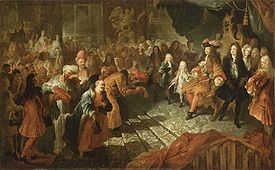
Persian embassy to Louis XIV
Encyclopedia

Louis XIV of France
Louis XIV , known as Louis the Great or the Sun King , was a Bourbon monarch who ruled as King of France and Navarre. His reign, from 1643 to his death in 1715, began at the age of four and lasted seventy-two years, three months, and eighteen days...
in 1715, the year of the Sun King's death. Mohammed Reza Beg, or in French sources Méhémet Riza Beg, was a high-ranking official to the Persian governor of the Yerevan
Yerevan
Yerevan is the capital and largest city of Armenia and one of the world's oldest continuously-inhabited cities. Situated along the Hrazdan River, Yerevan is the administrative, cultural, and industrial center of the country...
province (Armenia
Armenia
Armenia , officially the Republic of Armenia , is a landlocked mountainous country in the Caucasus region of Eurasia...
). He had been chosen by the Safavid Persian emperor Sultan Husayn for the mission and travelled with a grand entourage, as suitable to the diplomat of a mighty empire.
The embassy
The scene of the Persian ambassador's entry into Paris, 7 February 1715, was described by François Pidou de Saint-Olon (1646–1720), a nobleman who was delegated the diplomatic position of liaison officer to the Persian delegation:During several months that he spent at Versailles
Palace of Versailles
The Palace of Versailles , or simply Versailles, is a royal château in Versailles in the Île-de-France region of France. In French it is the Château de Versailles....
, Mohammed Reza Beg conducted negotiations towards establishing trade treaties between Persia and France, as well as on specific agreements concerning the installation of consulates. He conferred with the French on possible joint military operations against the Ottoman Empire
Ottoman Empire
The Ottoman EmpireIt was usually referred to as the "Ottoman Empire", the "Turkish Empire", the "Ottoman Caliphate" or more commonly "Turkey" by its contemporaries...
. But negotiations were impeded by Louis XIV's bad state of health. Nevertheless, Mohammed Reza Beg returned to Persia in autumn 1715 bearing treaties on commerce and friendship between France and Persia that had been signed in Versailles on 13 August. As another result of the diplomatic mission, a permanent Persian consulate was established in Marseille
Marseille
Marseille , known in antiquity as Massalia , is the second largest city in France, after Paris, with a population of 852,395 within its administrative limits on a land area of . The urban area of Marseille extends beyond the city limits with a population of over 1,420,000 on an area of...
, the main French Mediterranean port for the trade with the East, soon staffed by Hagopdjan de Deritchan.
Influences in literature
During the time he spent in ParisParis
Paris is the capital and largest city in France, situated on the river Seine, in northern France, at the heart of the Île-de-France region...
, however, feverish speculation ran rife about this exotic personage, his unpaid bills, his lavish but exotic lifestyle, the possibilities of amours, all concentrated in a pot-boiler romance of the beautiful but repeatedly kidnapped Georgian, Amanzolide, by M. d'Hostelfort, Amanzolide, nouvelle historique et galante, qui contient les aventures secrètes de Mehemed-Riza-Beg, ambassadeur du Sophi de Perse à la cour de Louis le Grand en 1715. (Paris: P. Huet, 1716). It was quickly translated into English, as Amanzolide, story of the life, the amours and the secret adventures of Mehemed-Riza-Beg, Persian ambassador to the court of Louis the Great in 1715 a true turquerie
Turquerie
Turquerie was the Orientalist fashion in Western Europe from the 16th to 18th centuries for imitating aspects of Turkish art and culture. Many different Western European countries were fascinated by the exotic and relatively unknown culture of Turkey, which was the center of the Ottoman Empire,...
, or fanciful Eastern imagining, which did not discriminate too finely between Ottoman Turkey and Safavid Persia.
More permanent literary results were embodied in Montesquieu
Charles de Secondat, baron de Montesquieu
Charles-Louis de Secondat, baron de La Brède et de Montesquieu , generally referred to as simply Montesquieu, was a French social commentator and political thinker who lived during the Enlightenment...
's Lettres Persanes
Persian Letters
Persian Letters is a literary work by Charles de Secondat, baron de Montesquieu, recounting the experiences of two Persian noblemen, Usbek and Rica, who are traveling through France.-Plot summary:...
(1725), in which a satiric critique of French society was placed in the pen of an imagined Persian homme de bonne volonté, a "man of good will".
See also
- Persian embassy to Europe (1599–1602)Persian embassy to Europe (1599–1602)The Persian embassy to Europe was dispatched by the Persian Shah Abbas I in 1599 to obtain an alliance against the Ottoman Empire. The Persians had then been at war with the Ottoman Empire for more than a century, and so decided to try to obtain European help against the Ottomans...
- Persian embassy to Europe (1609–1615)Persian embassy to Europe (1609–1615)The Persian embassy to Europe was dispatched by the Persian Shah Abbas I in 1609 to obtain an alliance with Europe against the Ottoman Empire. The embassy was led by the Englishman Robert Shirley.-Background:...
- Franco-Persian allianceFranco-Persian allianceA Franco-Persian alliance was formed for a short period between the French Empire of Napoleon I and the Persian Empire of Fath Ali Shah against Russia and Great Britain between 1807 to 1809. The alliance was part of a grand Napoleonic scheme to cross the Middle East in order to attack British India...
- France-Iran relations
- Franco-Ottoman allianceFranco-Ottoman allianceThe Franco-Ottoman alliance, also Franco-Turkish alliance, was an alliance established in 1536 between the king of France Francis I and the Turkish ruler of the Ottoman Empire Suleiman the Magnificent. The alliance has been called "the first non-ideological diplomatic alliance of its kind between a...

